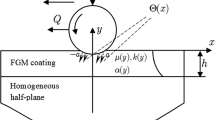Abstract
The rolling contact problem of a non-homogeneous layer is considered here. The graded layer possesses a variable elastic modulus with an exponential distribution. The Poisons ratio is assumed to be constant. A rigid cylindrical indenter is rolling over the surface of the graded layer with a constant velocity. First, the Navier equations of equilibrium are solved in the Fourier domain. Later, the boundary and the continuity conditions are satisfied in order to extract the governing singular integral equations. The numerical solution of the integral equations is provided by means of the Gauss–Chebyshev integration method. Finally, the sensitivity of the solution is analyzed for the effective parameters namely: the stiffness ratio, the layer thickness and the coefficient of friction. The results indicate that a minimum value of the coating thickness is required to alleviate the severe stress gradients in the critical locations. If the coating thickness decreases by a 50% then the Von Mises stress will increases about 20%. Also, a softening graded layer can result in a lower stress level over the interface which may enhance the bonding strength.













Similar content being viewed by others
References
Lee WY, Stinton DP, Berndt CC, Erdogan F, Lee YD, Mutasim Z (1996) Concept of functionally graded materials for advanced thermal barrier coating applications. J Am Ceram Soc 79(12):3003
Thivillon L, Bertrand P, Laget B, Smurov I (2009) Potential of direct metal deposition technology for manufacturing thick functionally graded coatings and parts for reactors components. J Nucl Mater 385(2):236
Mahamood RM, Akinlabi ET, Shukla M, Pityana S (2012) Functionally graded material: an overview. In: International association of engineers (IAENG)
Bandyopadhyay A, Krishna B, Xue W, Bose S (2009) Application of laser engineered net shaping (LENS) to manufacture porous and functionally graded structures for load bearing implants. J Mater Sci Mater Med 20(1):29
Bakirtas I (1980) The problem of a rigid punch on a non-homogeneous elastic half space. Int J Eng Sci 18(4):597
Bakirtaş İ (1984) The contact problem of an orthotropic non-homogeneous elastic half space. Int J Eng Sci 22(4):347
Jitcharoen J, Padture NP, Giannakopoulos AE, Suresh S (1998) Hertzian-crack suppression in ceramics with elastic-modulus-graded surfaces. J Am Ceram Soc 81(9):2301
Guler M, Erdogan F (1998) Contact mechanics of FGM coatings. In: Proceedings of 8th Japan—US conference on composite materials, pp 397–408
Dag S, Erdogan F (2002) A surface crack in a graded medium loaded by a sliding rigid stamp. Eng Fract Mech 69(14–16):1729
El-Borgi S, Keer L, Said WB (2004) An embedded crack in a functionally graded coating bonded to a homogeneous substrate under frictional Hertzian contact. Wear 257(7–8):760
Ke LL, Wang YS (2006) Two-dimensional contact mechanics of functionally graded materials with arbitrary spatial variations of material properties. Int J Solids Struct 43(18–19):5779
Yang J, Ke LL (2008) Two-dimensional contact problem for a coating-graded layer-substrate structure under a rigid cylindrical punch. Int J Mech Sci 50(6):985
Guler MA, Adibnazari S, Alinia Y (2012) Tractive rolling contact mechanics of graded coatings. Int J Solids Struct 49(6):929
Guler M, Alinia Y, Adibnazari S (2012) On the rolling contact problem of two elastic solids with graded coatings. Int J Mech Sci 64(1):62
Liu TJ, Wang YS, Xing YM (2012) The axisymmetric partial slip contact problem of a graded coating. Meccanica 47(7):1673
Chen P, Chen S (2013) Partial slip contact between a rigid punch with an arbitrary tip-shape and an elastic graded solid with a finite thickness. Mech Mater 59:24
Chen P, Chen S (2013) Thermo-mechanical contact behavior of a finite graded layer under a sliding punch with heat generation. Int J Solids Struct 50(7–8):1108
Çömez İ (2015) Contact problem for a functionally graded layer indented by a moving punch. Int J Mech Sci 100:339
Alinia Y, Beheshti A, Guler MA, El-Borgi S, Polycarpou AA (2016) Sliding contact analysis of functionally graded coating/substrate system. Mech Mater 94:142
El-Borgi S, Çömez I (2017) A receding frictional contact problem between a graded layer and a homogeneous substrate pressed by a rigid punch. Mech Mater 114:201
Su J, Ke LL, El-Borgi S, Xiang Y, Wang YS (2018) An effective method for the sliding frictional contact of a conducting cylindrical punch on FGPMs. Int J Solids Struct 141:127
Thai CH, Zenkour A, Wahab MA, Nguyen-Xuan H (2016) A simple four-unknown shear and normal deformations theory for functionally graded isotropic and sandwich plates based on isogeometric analysis. Composite Struct 139:77
Liu N, Jeffers AE (2017) Isogeometric analysis of laminated composite and functionally graded sandwich plates based on a layerwise displacement theory. Composite Struct 176:143
Hills D, Nowell D, Sackfield A (2013) Mechanics of elastic contacts. Elsevier, Amsterdam
Guler M (1996) The problem of a rigid punch with friction on a graded elastic medium. Master’s thesis, Lehigh University, Bethlehem
Author information
Authors and Affiliations
Corresponding author
Ethics declarations
Conflict of interest
The authors declare that they have no conflict of interest.
Appendix 1: The integrand function of the Fredholm kernels
Appendix 1: The integrand function of the Fredholm kernels
The integrand functions introduced in Eqs.18 and 20 are given as:
here
and:
In all mentioned equations, the symbol “ \(\bar{}\) ” stands for the complex conjugate of the corresponding variable.
Rights and permissions
About this article
Cite this article
Alinia, Y., Asiaee, A. & Hosseini-nasab, M. Stress analysis in rolling contact problem of a finite thickness FGM layer. Meccanica 54, 183–203 (2019). https://doi.org/10.1007/s11012-018-00925-w
Received:
Accepted:
Published:
Issue Date:
DOI: https://doi.org/10.1007/s11012-018-00925-w




